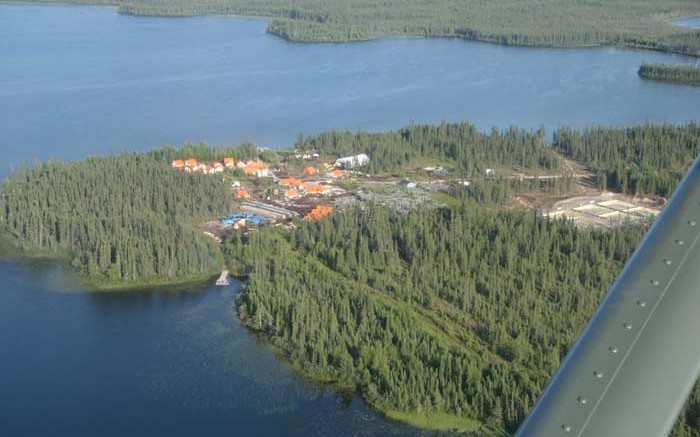VANCOUVER — Explorer Mega Precious Metals (TSXV: MGP) is sitting on a multi-million ounce gold-tungsten deposit at its Monument Bay project, and it sees a lot more upside across the 338 sq. km property, 340 km southeast of Thompson, Man. The company spent the past few years defining an open-pit resource along the regional Twin Lakes shear zone, but appears ready to turn its attention outward and hunt for satellite deposits along new regional structures.
The strategy is part of a pronged approach that president and CEO Glen Kuntz hopes will provide optionality at Monument Bay when it gets developed. Mega Precious aims to expand the project on three fronts that include: a potential depth extension of the current in-pit resources, an ongoing old core assay program (OCAP) and new target development.
Mega Precious’ OCAP began in August 2012 and has so far added 500,000 oz. gold at Monument Bay, and outlined tungsten credits.
Mineralized zones at the site occur in a pull-apart basin that consists of faulted-folded felsic volcanics, intruded by quartz-feldspar porphyry. Each of the zones holds quartz, albite, sericite shear veins and tension breccia that have heightened concentrations of tungsten (scheelite).
Current measured and indicated resources at Monument Bay total 47 million tonnes grading 1.43 grams gold for 2.2 million contained oz. The deposit also holds 248,000 tonnes of WO3. Since an October 2014 resource statement, the OCAP has sampled over 50% more tungsten samples above a cut-off grade of 0.13% WO3.
In April Mega Precious released results from OCAP that defined multiple parallel high-grade gold and tungsten mineralization within the company’s proposed open pit.
Recent highlights from the program include: 3 metres of 4.08 grams gold per tonne and 0.1% WO3 in hole 7; and 6.4 metres of 3.79 grams gold and 0.2% WO3 in hole 3-128.
“The OCAP has been significant. Since releasing our resource in November we’ve materially boosted our tungsten potential yet again. We’re also finding tungsten in a lot of new areas where we already have high-grade gold,” Kuntz comments during a phone interview.
“That’s important since, assuming you’re running a starter pit, you’ll be grabbing the tungsten at the same time. There are three main areas in our block models, and those three areas correlate well in terms of high-grade tungsten and gold. Obviously when you nearly double the amount of high grade in your database, it’s going to have a material effect,” he continues.
Meanwhile, Mega Precious assembled a geological think tank in November to generate promising regional targets.
The team put together data on structural trends, alteration, geophysics and geochemistry in order to create a ranking system for potential drilling. Kuntz says the company generated 28 targets, but narrowed it down to five priority areas.
The result was a 5,000-metre drill program earlier this year, which led to discovering the South Limb shear zone regional structure, 1 km south of Twin Lakes. Drilling intersected broad sericite-silica alteration with associated gold mineralization comparable to alteration at the Twin Lakes and Mid-East deposits.
Mega Precious suspects that extensive alteration zones and associated gold and multi-metal mineralization in all drill holes along the South Limb indicates a large hydrothermal system that could host similar deposits to Twin Lakes.
“I really look at the recent drilling as a proof-of-concept program. We’re looking to determine whether we can host multiple orebodies and how we go about drilling more deposits. I think the answer is definitely ‘yes,’” Kuntz elaborates.
“The encouraging thing about South Limb is that we’ve hit anomalous gold mineralization, which is a good start. We’ve also been hitting ultramafics, and that’s a bit of a different style. It’s exciting we’re seeing different geological settings that could host mineralization. Our step-outs have basically doubled our regional knowledge,” he continues.
The company also tested a second section of the South Limb — 11 km along strike to the east — called the “Altered Boot” target. Drilling intersected broad sericite, altered volcanics and sediments, and localized silica-fuchsite alteration in areas near quartz veining with pyrite, arsenopyrite and molybdenite mineralization. Assays on Altered Boot are pending.
Mega Precious had just under $2 million in cash at press time, and traded near a 52-week low at 4.5¢ per share. The company has 173 million shares outstanding for a $7.8-million market capitalization.
“For us to go alone on this we need a lot of capital. So is there some sort of combination where we’d have an earn-in from a major or something like that? I’d say it’s definitely on the table, and we’ve had a lot of mining companies up to our site over the past few months,” Kuntz comments. “There are not many jurisdictions that have the security and geological potential we’re talking about at Monument.”


Be the first to comment on "Mega Precious hits regional targets at Monument Bay"